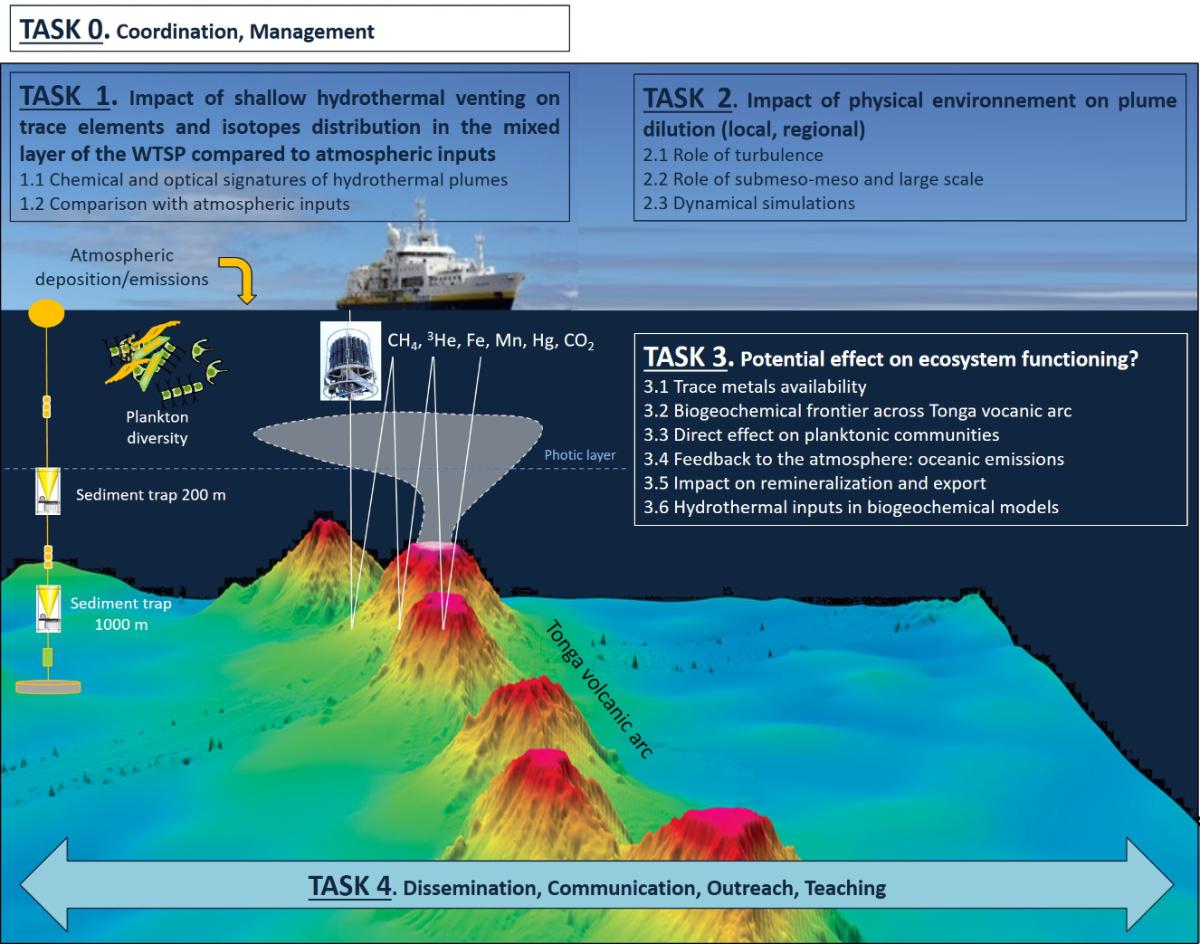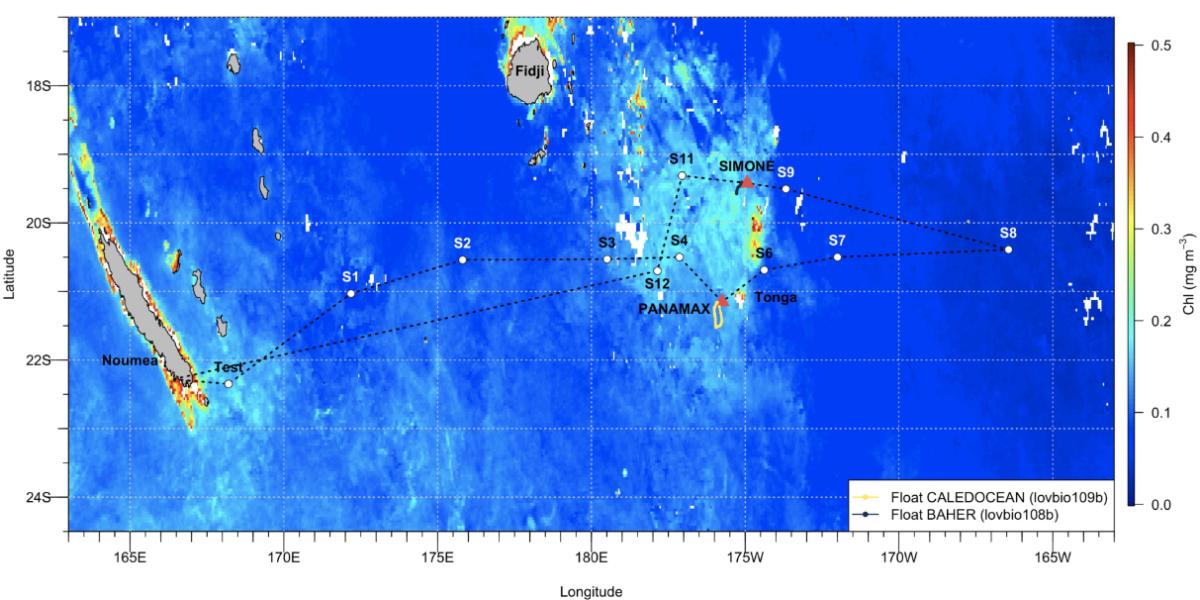References of International Seminar Communications
Audax M., Boniface T., Claustre H., Cornec M., Ferraris M., Fourrier M., Guieu C., Jessin T., Loïc Le Ster L. Lombard F., Penkerc'h C., Petit F., Poteau A., Terrats L. & Scheurle C., (2022) Adopt a float: an international educational program to discover the Ocean and marine sciences, ASLO Ocean Science Meeting 2022, 24 Feb- 4 March 2022, Virtual
Berthelier C., Henry N., Leconte J., Ferrieux M., Bigeard E., Ratin M., Le Gall F., Romac S., Jeanthon C., Guillou L., De Vargas C., Partensky F., Not F., Guieu C., Bonnet. C, Baudoux AC and Garczarek L., (2022) Diversity analysis of planktonic communities in the South-West Pacific Ocean influenced by Tonga's volcanic arc, Gen2Bio La Baule 2022: 24-25 March
Berthelier C., Henry N., Leconte J., Ferrieux M., Bigeard E., Ratin M., Le Gall F., Romac S., Jeanthon C., Guillou L., De Vargas C., Partensky F., Not F., Guieu C., Bonnet. C, Baudoux AC and Garczarek L., (2022) Diversity analysis of planktonic communities in the South-West Pacific Ocean influenced by Tonga's volcanic arc, JOBIM Rennes 2022: 5-8 July
Bonnet S. & Cecile Guieu C. and the TONGA team, (2022) An oasis in the desert: shallow hydrothermal iron triggers massive diazotroph blooms in the subtropical Pacific Ocean, ASLO Ocean Science Meeting 2022, 24 Feb- 4 March 2022, Virtual
Forrer H., Bonnet S., Thomas R., Grosso O., Guieu C., Knapp A., (2022) Geochemical signatures of nitrogen fixation in the western subtropical South Pacific: d15N budgets and low-d15N DON, ASLO Ocean Science Meeting 2022, 24 Feb- 4 March 2022, Virtual
Léo Mahieu, Hannah Whitby, Gabriel Dulaquais, Chloé Tilliette, Matthieu Bressac, Veronica Arnone, David González-Santana, Géraldine Sarthou, Hélène Planquette, Cécile Guieu, Sophie Bonnet, Pascal Salaün, Iron-binding ligands in the shallow hydrothermal system of the Tonga-Kermadec volcanic: distribution, strength, and dynamic, Challenger Conference 150, 5-8 September 2022, (2022)
Portlock G., Fourrier P., Dulaquais G., Riso R., Salaun P., Whitby H, Bonnet S., Guieu C ., & Gazeau F., (2022) Distribution of thiol and humic substances during the 2019 TONGA Cruise, ASLO Ocean Science Meeting 2022, 24 Feb- 4 March 2022, Virtual
Portlock G., Gazeau F., Bonnet S., Guieu C., Whitby H., Salaun P., (2022) Distribution of thiol and humic substances during the 2019 TONGA Cruise, Challenger 2022, 5 Sept - 8 Sept.
Tilliette C., Taillandier V., Bouruet-Aubertot P., Grima N., Maes C., Montanes M., Sarthou G., Vorrath M-E, Arnone V., Bressac M., Gonzalez-Santana D., Gazeau F. & Guieu C, 2022, dFe pattern impacted by shallow hydrothermal sources along a transect through the Tonga-Kermadec arc, ASLO Ocean Science Meeting 2022, 24 Feb- 4 March 2022, Virtual
Vigier N., Weppe L., Tilliette C., Chavagnac V., Boulart C., Thibon F., Lombard F., Montanès M., Guieu C. & Bonnet S., (2022) Lithium concentration and Li isotope composition of plankton from the Tonga volcanic arc: influence of shallow hydrothermal fluids, ASLO Ocean Science Meeting 2022, 24 Feb- 4 March 2022, Virtual
Vigier, N., Weppe, L., Tilliette, C., Chavagnac, V., Boulart, C., Thibon, F., .Guieu C. & Bonnet, S., (2022) Impact of shallow hydrothermalism on lithium content and lithium isotope composition of marine plankton. Goldschmidt2022.
Alba Filella, France Van Wambeke, Elvira Pulido-Villena, Sandra Nunige, Olivier Grosso, Sophie Bonnet, Lasse Riemann, Solange Duhamel, Julia M. Diaz, Mar Benavides, (2021) P-anhydrides as a potential source of P for diazotrophs in the Western Tropical South Pacific (WTSP), ASLO Aquatic Sciences Meeting 2021: 22 - 27 June, Virtual
Forrer H., Bonnet S., Grosso O., Guieu C., Knapp A., (2021) Quantifying di-nitrogen fixation and its contribution to export production using d15N budgets near the Tonga arc in the western subtropical South Pacific ASLO Aquatic Sciences Meeting 2021: 22 - 27 June, Virtual
Fourrier, P., Dulaquais, G., Tilliette, C., Guieu, C., & Riso, R. (2021). Vertical and spatial distribution of the iron-humic complex during the TONGA GPpr14 expedition, Goldschmidt2021 4-9 July Virtual
Le Moal P, Boulart C, Garczarek L, Gac J.P, Bigeard E, Ferrieux M, Bonnet S and Guieu C., (2021) Potential role of marine picocyanobacteria in the distribution of dissolved methane in the Southwest Pacific Ocean, ASLO Aquatic Sciences Meeting 2021: 22 - 27 June, Virtual
Lory C., Van Wambeke F., Fourquez M., Berman-Frank I., Barani A., Tilliette C., Marie D., Nunige S., Guieu C. and Bonnet S., (2021) A group-specific approach to quantify iron uptake by diazotrophs and associated microbial communities, ASLO Aquatic Sciences Meeting 2021: 22 - 27 June, Virtual
Thesis using campaign data
Arnone Veronica (2024). The Organic Complexation of Iron and Copper in Marine Environments. PhD Thesis, Universidad de Las Palmas de Gran Canaria.
Tilliette Chloé (2023). Influence du fer et autres éléments traces issus des sources hydrothermales peu profondes sur la biogéochimie marine dans le Pacifique Sud-Ouest / Influence of iron and other trace elements from shallow hydrothermal sources on marine biogeochemistry in the Western Tropical South Pacific Ocean. PhD Thesis, Université Sorbonne.
Portlock Gemma (2023). The sources and sinks of thiols, reduced sulphur substances, and humic-like substances in hydrothermal waters. PhD Thesis, University of Liverpool.
Mahieu Léo Paul (2023). Analytical challenges, development and application of CLE-ACSV for the determination of the organic speciation of iron in marine waters. PhD Thesis, University of Liverpool.
Panetier Aurélie (2023). Shipborne Global Navigation Satellite Systems for Offshore Atmospheric Water Vapor Monitoring. PhD Thesis, ENSTA Bretagne.
Baumas Chloé (2023). Variations in remineralization rates in marine particles : Influence of their typology and associated diversity. PhD Thesis, Université d'Aix-Marseille.
ABABOU Fatima-Ezzahra, (2023) Devenir de la fixation d'azote dans l'océan, Aix-Marseille University
ARNONE Veronica, (2023) Organic complexation of Fe and Cu in marine environments Universidad de Las Palmas de Gran Canaria
FILELLA Alba (2023) Relation diazotrophie/DOM dans l'ocean, Aix-Marseille University
FOURRIER Pierre (2023), Biogeochemistry of Dissolved Organic Matter in the Pacific Ocean, Université de Bretagne Occidentale
Fourrier Pierre (2022). Biogéochimie de la matière organique dissoute dans l'Océan Pacifique / Biogeochemistry of dissolved organic matter in the Pacific Ocean. PhD Thesis, Université de Bretagne Occidentale.
Ferrieux Mathilde (2022).
Adaptation à la température et à la limitation en fer chez un représentant majeur du phytoplancton marin, la picocyanobactérie Synechococcus. PhD Thesis, Université Sorbonne.
https://archimer.ifremer.fr/doc/00886/99797/Lory Caroline (2022). Rôle du fer dans le contrôle de la fixation d'azote atmosphérique dans l'océan Pacifique tropical sud-ouest. PhD Thesis, Université Aix Marseille.
FORRER Heather (2022), Sources of nitrogen fueling export production using nitrogen isotope budgets, Florida State University
MAHIEU Léo, (2022), Impact of pH on Fe organic complexation in the ocean, University of Liverpool
PORTLOCK Gemma (2022), The sources and sinks of thiols, humic substances and sulfides in hydrothermal waters, University of Liverpool
Gonzalez Santana David (2020). Processus contrôlant la dispersion et la spéciation redox du fer dissous d'origine hydrothermale (dorsale médio-atlantique) / Processes driving the dispersion and redox speciation of hydrothermally sourced dissolved iron (Mid-Atlantic Ridge). PhD Thesis, Université de Bretagne Occidentale.



